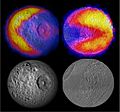Datoteka:PIA16198.jpg
Izgled

Veličina ovog prikaza: 644 × 599 piksela. Ostale razlučivosti: 258 × 240 piksela | 516 × 480 piksela | 660 × 614 piksela.
Vidi sliku u punoj veličini (660 × 614 piksela, veličina datoteke: 62 KB, MIME tip: image/jpeg)
Povijest datoteke
Kliknite na datum/vrijeme kako biste vidjeli datoteku kakva je tada bila.
| Datum/Vrijeme | Minijatura | Dimenzije | Suradnik | Komentar | |
|---|---|---|---|---|---|
| sadašnja | 17:01, 18. kolovoza 2013. |  | 660 × 614 (62 KB) | Nova13 | {{Information |Description ={{en|1=Scientists with NASA's Cassini mission have spotted two features shaped like the 1980s video game icon "Pac-Man" on moons of Saturn. One was observed on the moon Mimas in 2010 and the latest was observed on the moo... |
Uporaba datoteke
Na ovu sliku vode poveznice sa sljedećih stranica:
Globalna uporaba datoteke
Sljedeći wikiji rabe ovu datoteku:
- Uporaba na de.wikipedia.org
- Uporaba na lb.wikipedia.org


